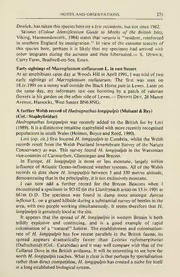
Early sightings of Macroglossum stellatarum L. in East Sussex PDF
Preview Early sightings of Macroglossum stellatarum L. in East Sussex
NOTES AND OBSERVATIONS 271 Dewick, has taken this species here on a few occasions, but not since 1982. Skinner {Colour Identification Guide to Moths of the British Isles, Viking, Harmondsworth, 1984) states that vetusta is "resident, reinforced in southern England by immigration." In view of the extreme scarcity of this species here, perhaps it is likely that my specimen had arrived with — other imigrants during the autumn and then hibernated. S. Dewick, Curry Farm, Bradwell-on-Sea, Essex. Early sightings ofMacroglossum stellatarum L. in east Sussex At an amphibians open day at Woods Hill in April 1991, I was told of two early sightings of Macroglossum stellatarum. The first was seen on 18.iv.1991 on a sunny wall outside the Black Horse pub in Lewes. Later on the same day, my informant saw one hovering by a patch of valerian — flowers in his garden on the other side of Lewes. Dennis Dey, 26 Manor Avenue, Hassocks, West Sussex BN6 8NG. A further Welsh record ofHadrognathuslongipalpis (Mulsant & Rey) (Col.: Staphylinidae) Hadrognathus longipalpis was recently added to the British list by Lott (1989). It is a distinctive omaliine staphylinid with more recently recognised populations in south Wales (Holmes, Boyce and Reed, 1990). Lott (op. cit.) first located H. longipalpis in Cumbria, whilst the Welsh records result from the Welsh Peatland Invertebrate Survey of the Nature Conservancy as was. This survey found H. longipalpis in the Watsonian vice-counties ofCarmarthen, Glamorgan and Brecon. In Europe, H. longipalpis is more or less montane, largely within influence of Atlantic Ocean-influenced weather systems. All of the Welsh records to date show H. longipalpis between 5 and 330 metres altitude, demonstrating that in the principality, it is not exclusivelymontane. I can now add a further record for the Brecon Beacons when I encountered a specimen in SO 02 (in the Llanfrynach area) on 13.iv.1991 at 661m O.D. The specimen was found in damp moss amongst Juncus inflexus L. on a grazed hillside during a substantial survey of beetles in the area, with two people working simultaneously. It seems therefore that H. longipalpisis genuinely local at the site. It appears that the spread of H. longipalpis in western Britain is both mildly explosive and continuing, and is a good example of rapid colonisation of a "natural" habitat. The estabHshment and colonisation- rate of H. longipalpis has few recent parallels in the British fauna; its spread appears dramatically faster than Leistus rufomarginatus (Duftschmid) (Col.: Carabidae) and it may well compare with that of the Collared Dove in the British avifauna. It will be interesting to see how far north H. longipalpisreaches. What is clear is that perhaps by specialisation rather than direct competition, H. longipalpis has created a niche for itself in along established biological system.
